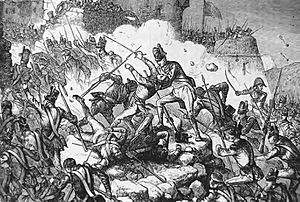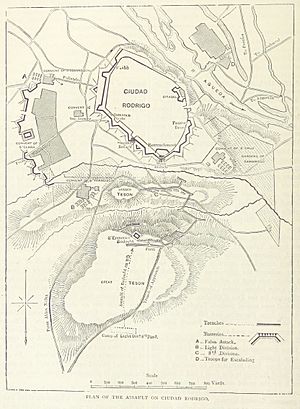Siege of Ciudad Rodrigo (1812) facts for kids
Quick facts for kids Siege of Ciudad Rodrigo (1812) |
|||||||
|---|---|---|---|---|---|---|---|
| Part of the Peninsular War | |||||||
 British infantry storm the fortress at Ciudad Rodrigo during Wellington’s campaign in Spain |
|||||||
|
|||||||
| Belligerents | |||||||
| Commanders and leaders | |||||||
|
|||||||
| Strength | |||||||
| 1,800-2,000 153 guns |
10,700-40,000 36 guns |
||||||
| Casualties and losses | |||||||
| 529-800 killed or wounded 1,000-1,471 captured |
250-318 killed 1,100-1,378 wounded |
||||||
The Siege of Ciudad Rodrigo happened from January 7 to 20, 1812. During this time, the Anglo-Portuguese Army, led by Viscount Wellington, attacked the French soldiers defending the city of Ciudad Rodrigo in Spain. The French garrison was commanded by General of Brigade Jean Léonard Barrié.
British cannons created two large holes, called breaches, in the city walls. On the evening of January 19, 1812, the Allied troops successfully stormed the fortress. After entering the city, some British soldiers lost control and caused damage for several hours before order was restored. Wellington's army lost about 1,700 men, including two generals. This victory was very important because it opened a path for the Allied forces to enter French-controlled Spain from British-held Portugal. Two years earlier, in 1810, the French had captured Ciudad Rodrigo from Spanish forces.
Contents
Why the Siege Happened
The siege of Ciudad Rodrigo was an important part of the Peninsular War. This war was fought between France and a group of countries including Britain, Portugal, and Spain. The Allied forces wanted to push the French out of Spain. Taking Ciudad Rodrigo was a key step in their plan to start a major campaign in Spain.
Getting Ready for the Attack
Napoleon, the leader of France, had ordered his general, Marshal Auguste Marmont, to send some of his troops to other battles. When Wellington, the Allied commander, found out that Marmont's army was split up, he decided it was a good time to attack Ciudad Rodrigo.
Wellington and his chief engineer, Lt. Col. Fletcher, arrived near Ciudad Rodrigo on January 6, 1812. They looked at the city's defenses the next morning.
Ciudad Rodrigo was a fortress with a main wall about 32 feet (9.8 m) high. The wall was not very strong. A 600-foot (180 m) high hill called the Grand Teson overlooked the city. The French had built a small fort, called a redoubt, on this hill. The French commander, Barrié, had only about 2,000 soldiers. This was not enough to properly defend all parts of the fortress. His troops included infantry, sappers (engineers), and only 167 artillerists to manage 153 cannons.
The Attack Begins
On the night of January 8, the Allied Light Division surprised the French and captured the Grand Teson redoubt. After taking the redoubt, the Allied soldiers began digging trenches. These trenches would lead to places where they could set up their large cannons to break through the city walls. Digging in the rocky ground at night was difficult. When a pickaxe hit a stone, it would create a spark. The French soldiers could see these sparks and would fire their guns at them.
By January 12, the trenches were finished, and the cannons were being put into place. Wellington learned that Marshal Marmont's army might be coming to help the French in Ciudad Rodrigo. So, Wellington decided the siege had to happen very quickly.
On January 13, Allied troops stormed the Santa Cruz Convent, which was on the right side of the city. The next day, January 14, French soldiers tried to fight back with 500 men, but they were pushed away. That same night, soldiers from the 40th Regiment of Foot climbed the walls of the San Francisco Convent on the left side. They were successful, and all French troops had to retreat inside the city walls.
The Allied cannons began firing at 4 PM on January 14. They used thirty-four 24-pound cannons and four 18-pound cannons. Over five days, these guns fired more than 9,500 cannonballs. They created two large holes in the city walls. One was a big hole in the main wall, and the other was a smaller hole in a weak tower. Wellington then ordered his troops to storm the city on the night of January 19.
Storming the City
Wellington planned the main attack with about 10,700 soldiers. Major-General Thomas Picton's 3rd Division was ordered to attack the larger hole in the northwest wall. Robert Craufurd's Light Division was sent to attack the smaller hole in the north. Other Portuguese troops also made smaller attacks to distract the French.
The main attack started at 7 PM. The soldiers attacking the larger hole faced strong resistance. However, the soldiers attacking the smaller hole had an easier time. They managed to get through the wall and then got behind the French defenders at the larger hole. This made it impossible for the French to keep fighting, and the attack was a complete success.
Two cannons had been placed in the wall of the larger hole, causing many casualties during the storming. The 88th Connaught Rangers Regiment captured one of these cannons, and the 45th Nottinghamshire Regiment captured the other.
The Allied forces suffered 195 soldiers killed and 916 wounded during the attack. Sadly, two important generals, Henry MacKinnon and Robert Craufurd, were among those who died. After the city was captured, some British soldiers, upset by their losses, lost discipline. They caused damage and took things from the city, even though the people living there were Spanish and allies. Officers worked hard to bring order back.
What Happened Next
The French soldiers defending Ciudad Rodrigo lost 529 men killed or wounded. The rest were captured. The French army also lost all their siege equipment, including 153 cannons.
The quick capture of Ciudad Rodrigo surprised Marshal Marmont. He had thought the city would hold out for three weeks. This would have given him enough time to gather his troops at Salamanca to help. But the city fell in less than two weeks. Marmont, with his 32,000 troops, decided not to try to take it back. He needed his soldiers to defend other towns and forts.
Wellington was rewarded for his victory. The British gave him a special title, an earldom, and a large pension. The Spanish also honored him by making him the Duke of Ciudad Rodrigo.
Taking Ciudad Rodrigo was very important. It opened a way for the Allied army to invade Spain from Portugal in the north. It also allowed Wellington to move on to attack Badajoz in the south. The siege of Badajoz would be a much bloodier battle.
The Allied campaign in Spain continued with the siege of Badajoz.
See also
 In Spanish: Sitio de Ciudad Rodrigo (1812) para niños
In Spanish: Sitio de Ciudad Rodrigo (1812) para niños


